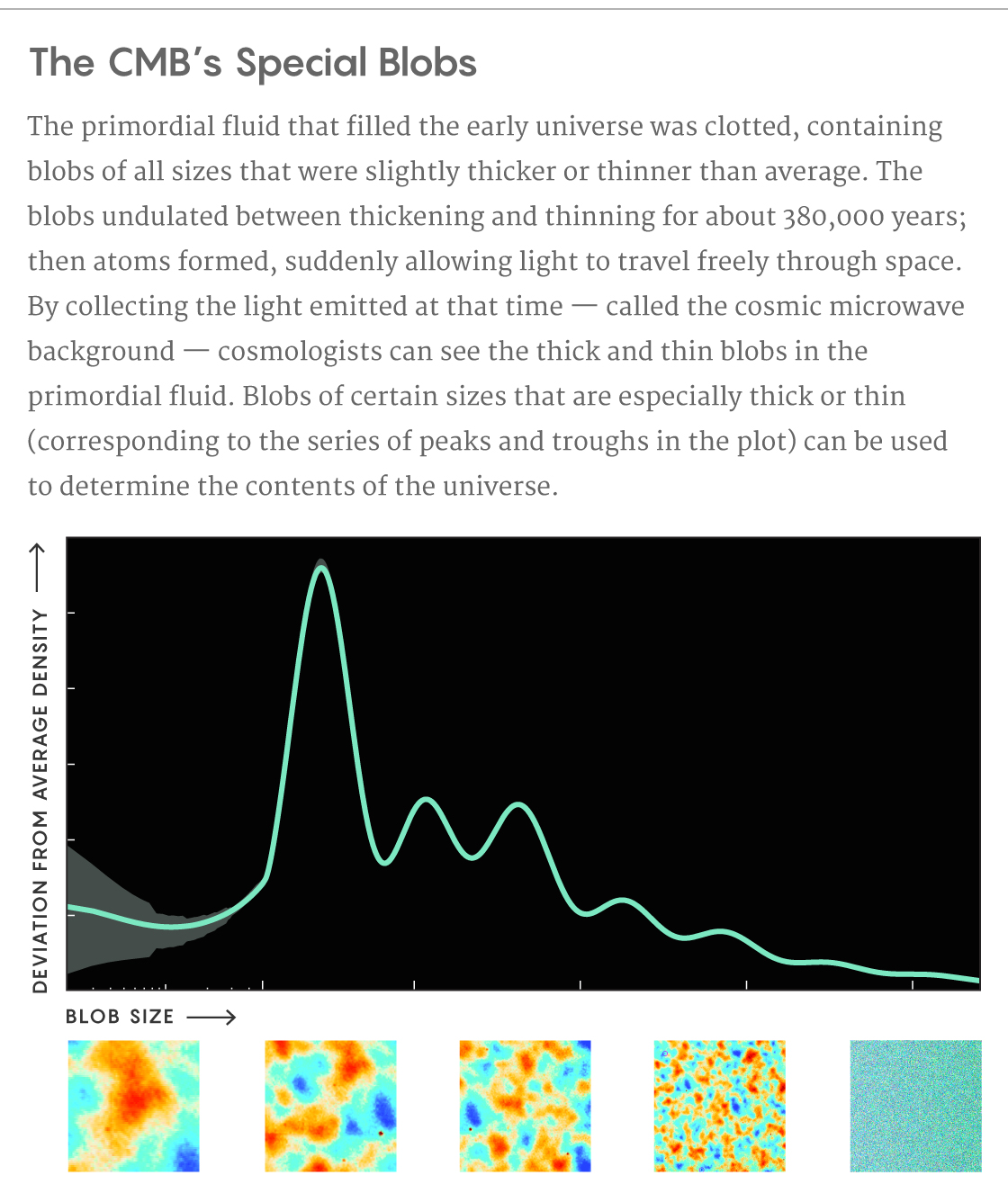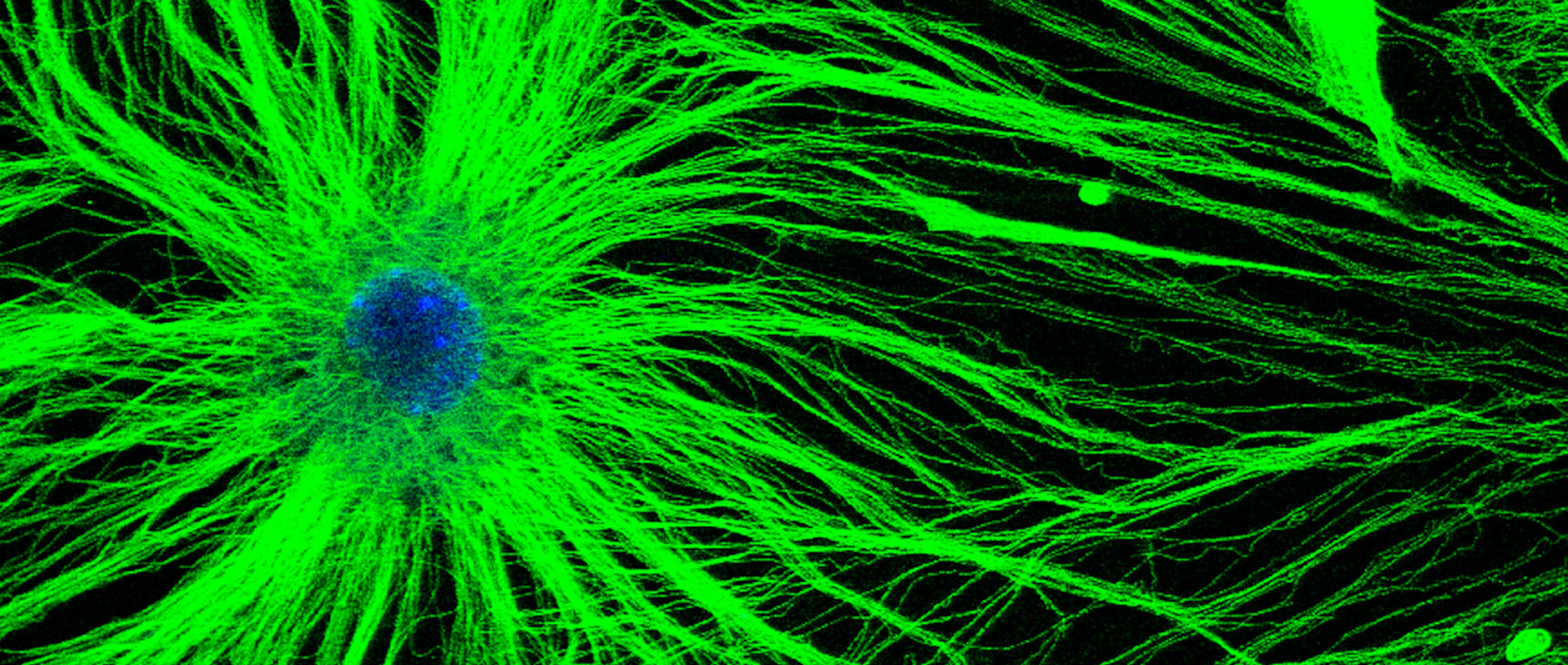How Ancient Light Reveals the Universe’s Contents
Introduction
In early 2003, Chuck Bennett learned the precise contents of the cosmos.
By then, most cosmologists had concluded that the universe contains much more than meets the eye. Observations of pinwheeling galaxies suggested that scaffolds of invisible matter held their stars together, while a repulsive form of energy drove galaxies apart. To learn more, Bennett and his Wilkinson Microwave Anisotropy Probe (WMAP) team had spent a year collecting microwaves coming from all directions in the sky — light rays that left their source long ago, when the universe was just 380,000 years old. By snapping this photograph of the young cosmos, the WMAP team could pin down its age and shape and determine exactly how much so-called dark matter and dark energy it contains.
“All of a sudden we had this list of numbers,” recalled Bennett, an astrophysicist at Johns Hopkins University.
The team announced their first results in February 2003. Their map of the “cosmic microwave background” (CMB), which they refined in subsequent years, indicated that the familiar matter of planets, gas and stars makes up just 4.6% of the cosmos, while unseen dark matter comprises 24%. The remaining 71.4% of the cosmic pie chart had to be dark energy, which is thought to infuse the fabric of space itself. The numbers changed only a little when WMAP’s successor, the Planck satellite, took an even sharper image of the CMB 10 years later. And whereas other evidence of dark energy and dark matter continues to be contested, their fingerprints in the CMB have gone virtually unquestioned.
The CMB is “definitely one of, if not the most important, pillar of modern cosmology,” said Yacine Ali-Haïmoud, an astrophysicist at New York University.
Here’s how the universe scrawled such a telling message in the cosmic microwave background, and how researchers learned to read it.
In the beginning, before the microwaves left their source, the universe was a nearly featureless fluid made of dark and visible matter. This primordial substance once shone white-hot, then cooled to a light orange over the universe’s first few hundred thousand years. Light rays couldn’t travel far before ricocheting off neighboring particles. This scattered light kept the fluid foggy and pressurized.
But the seeds of today’s stars and planets had already been sown. Nothing in nature is perfect, and the smooth primordial soup came ever so slightly clotted, with some regions about a thousandth of a percent denser than the surrounding fluid, and some that much thinner.
The fluid sloshed as gravity pulled matter together and light waves pushed it apart. This tug-of-war thinned dense spots as excess matter spilled outward and thickened thin spots as material rushed inward. When one area got too thin, particles would rush in again, and vice versa, so that each blob swung back and forth between high and low density. Fortunately, physicists have all the theoretical tools they need to analyze such undulations of a simple fluid at a reasonable temperature. “The physics is really pretty old,” Ali-Haïmoud said.
The CMB captures the sloshing fluid at a particular time. After expanding for about 380,000 years, the cosmos cooled enough for protons and electrons to pair off into hydrogen atoms, an event called recombination. With few charged particles to bang into, light beams suddenly became free, releasing the pressure and freezing the density blobs in place. Since then, the expanding universe has stretched the wavelengths of the liberated light rays into microwaves. By collecting them from all over the sky, the WMAP and Planck telescopes caught the early universe and its contents mid-slosh. Their maps reveal a blotchy pattern of denser spots and thinner spots, signified by microwaves that measure a fraction of a degree warmer or cooler (just as blue indicates a hotter flame than yellow).

Lucy Reading-Ikkanda/Quanta Magazine; source: DOI: 1303.5076v3
The key to deciphering the CMB’s messy ripples is that recombination granted a select series of blobs an enduring cosmic significance. Consider a thick blob of primordial matter just large enough to take 380,000 years to completely thin out, at which point recombination froze it as an eternal thin spot. Larger spots didn’t have time to fully thin, and smaller spots would have started to thicken again. One particular set of smaller blobs had enough time to go from peak thickness to peak thinness back to peak thickness again. Yet another set of even smaller spots completed exactly three transitions, and others four.
Researchers analyze the overlapping static of the CMB by blurring the map to varying extents and plotting the density variations that they see. The resulting plot, called the CMB power spectrum, has a series of peaks representing the sizes of the special blobs that reached maximum thickness or thinness at the time of recombination. Had the universe developed otherwise or contained some other cosmic mixture, a different tonal pattern would have frozen at recombination, one that scientists could tell apart just as the ear can distinguish between a piano and a clarinet, said Scott Dodelson, a cosmologist at Carnegie Mellon University.
The largest spots span 1 angular degree on the modern sky, about twice the width of the full moon. From this, cosmologists can infer the shape of the universe — whether space is flat, so that parallel light rays stay parallel, or curved like a saddle or a sphere. Matter and energy curve space, an effect we experience as gravity. The expansion of the universe, meanwhile, flattens space, and for a while cosmologists weren’t sure whether one side was winning. Different curvatures would make the largest blobs look bigger or smaller in the CMB (think of how the apparent sizes of Africa and Greenland get distorted if we flatten the round globe), but the 1-degree size of the largest blobs matches expectations for a flat universe. WMAP found a universe with enough content to keep light rays flying true to within 0.4%.
Smaller blobs reveal the cosmos’s composition. Their sizes, and how thick or thin they became, depended on the ingredients of the liquid, much as clam chowder splashes differently than chicken soup. In the primordial fluid, dark matter felt the pull of gravity, but not the electromagnetic push from light rays. Normal matter responded to both. Tesla Jeltema, a cosmologist at the University of California, Santa Cruz, explained that researchers can distinguish these two fluid components by comparing the intensity with which blobs of different sizes sloshed inward and outward — the relative heights of the peaks in the power spectrum.
No one has identified dark matter particles, yet the CMB reveals the large-scale behavior of the elusive substance. Ali-Haïmoud likens the situation to premodern scientists understanding buoyancy and pressure even without knowing that the chemical formula for water was H2O. Any attempt to explain away the apparent influence of dark matter, such as by tweaking the laws of gravity, will have to match the particular pulsations of the primordial fluid. No model has yet risen to the challenge.
Dark energy, meanwhile, played a negligible role in the universe’s youth. Its presence can be inferred from the CMB’s indication that the universe is flat today. The measured quantities of dark and visible matter just don’t have the muscle to flatten space. But add 71.4% dark energy to the modern universe, and everything balances.
This picture isn’t perfect, as recent astronomical observations have suggested that today’s universe is expanding at a faster clip than the CMB recipe implies it should be. But WMAP and Planck data have set a high bar for theorists seeking alternative, non-dark explanations for the motions of stars and galaxies. “Now that we have these detailed maps,” Dodelson said, “the CMB by itself is pretty damn good at getting almost everything.”



